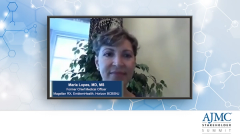
Pulmonary Rehabilitation and COPD
Nonpharmacological strategies that can help engage patients to remain adherent to therapies used to treat chronic obstructive pulmonary disease.
Episodes in this series

Neil Minkoff, MD: One of the other things that we touched on quite a few times was the role of pulmonary rehab—a nonpharmacological therapy to try to improve everything. There’s always been some concern that patients are less engaged with pulmonary rehab rather than looking for the next medication or a different inhaler or something like that. Could you touch on the importance of pulmonary rehab? What are the different strategies you use to try to get patients engaged in what can be a strenuous process? Mr Hess?
Michael Hess, MPH, RRT, RPFT: You raised a great point. There is a lot of engagement issue, but there are a ton of barriers in general. A lot of clinicians may figure this person is not going to be able to go or not going to get benefit from it. Frankly, there are a lot of logistical barriers too. We have people who get short of breath using the restroom, so if you tell them, “We’re going to put you on a treadmill for 10 minutes,” or whatever it is, they’re going to look at you like you might have 2 heads growing out of you.
It’s really important to present these things in a way that people are going to engage with them. We need to find that motivation. We need to explain that we know it’s going to be difficult, but they’re going to ease you into it. It’s going to be an ongoing process. It’s going to be difficult work, but it’s going to be worth it in the long run. I also feel that we need to get away from this idea of pulmonary rehabilitation. As we have the system set up right now, we look at it as 36 sessions and then that’s it: You’re fixed, you’re done, and everything is going to be fine. But the goal of these things is to actually get people to live long and prosper, so to speak. We need to be looking at this as more of a long-term investment. We need to be having these supplemental sessions that go on past the initial run-in period and keep people fit. We need to look at it as more of a pulmonary fitness than a pulmonary rehab.
Finally, we’re going to need to use telehealth. One of the arguable silver linings of the pandemic has been much more widespread adoption of various telehealth services. There are a few tele-rehab programs right now, and as we get better with monitoring and 2-way communications and everything else, we really need to continue investigating its use in COPD [chronic obstructive pulmonary disease]. Because even when that fine day comes that COVID-19 [coronavirus disease 2019] is in our rearview mirror, COPD is still going to be around, and those folks are still going to have those same physical and logistical issues getting to the programs—particularly in rural areas. If we can come to them instead, it’s going to increase outcomes and increase adherence.
Neil Minkoff, MD: Have you seen that around telehealth as well? How are you evaluating patients using telehealth?
M. Bradley Drummond, MD, MHS: COVID-19 will be an accelerant for telehealth. As an example: My COPD clinic, which every week was 100% in person pre-COVID and is now 97% virtual. We have had to teach patients how to use virtual resources. As providers, we have had to learn how to use virtual resources ourselves, which is always a challenge. But that will likely be here to stay, in some component.
Our clinic base is a large rural catchment area, because I live in North Carolina, so this has helped enhance access to many of our patients who have transportation issues. Perhaps they don’t have enough oxygen to support them on a 3-hour car drive to and from the clinic. Those logistical barriers are no longer in play. Fortunately, a lot of what we do in COPD is about symptom assessment. It’s about understanding exacerbation history [and discerning it] from a telehealth visit, which may be different from a cardiologist who needs to really auscultate a murmur and those sorts of things. Telehealth is here to stay.
I am very excited about the clinical virtual pulmonary rehabilitation. In general, only 3% of patients with COPD actually attend pulmonary rehabilitation. We talk about it as physical therapy for the lungs. I think patients are more familiar with physical therapy than rehab. In conventional in-person pulmonary rehab, we focus a lot on the ability to overcome social isolation, which is a big component of 1 of the comorbidities of COPD.
You can be with other people, who are improving along with you and you can get engagement from nurses and respiratory therapists who teach you how to use your inhalers correctly. We actually de-emphasized a lot of the exercise component and try to engage patients through the other potential benefits of improving social isolation, health, nutrition, and inhaler technique. Thinking creatively about how to continue the social component of pulmonary rehab in a virtual setting will be very exciting to see.
This activity is supported by an educational grant from Boehringer Ingelheim.
Newsletter
Stay ahead of policy, cost, and value—subscribe to AJMC for expert insights at the intersection of clinical care and health economics.








